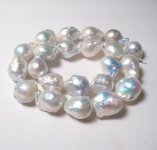Lady_Disdain
Member
- Joined
- Aug 3, 2014
- Messages
- 866
The description says South Sea but they look a lot like freshwater to me.

https://www.etsy.com/listing/951357...erest&utm_medium=PageTools&utm_campaign=Share
If it helps, the price originally was $199.

https://www.etsy.com/listing/951357...erest&utm_medium=PageTools&utm_campaign=Share
If it helps, the price originally was $199.
